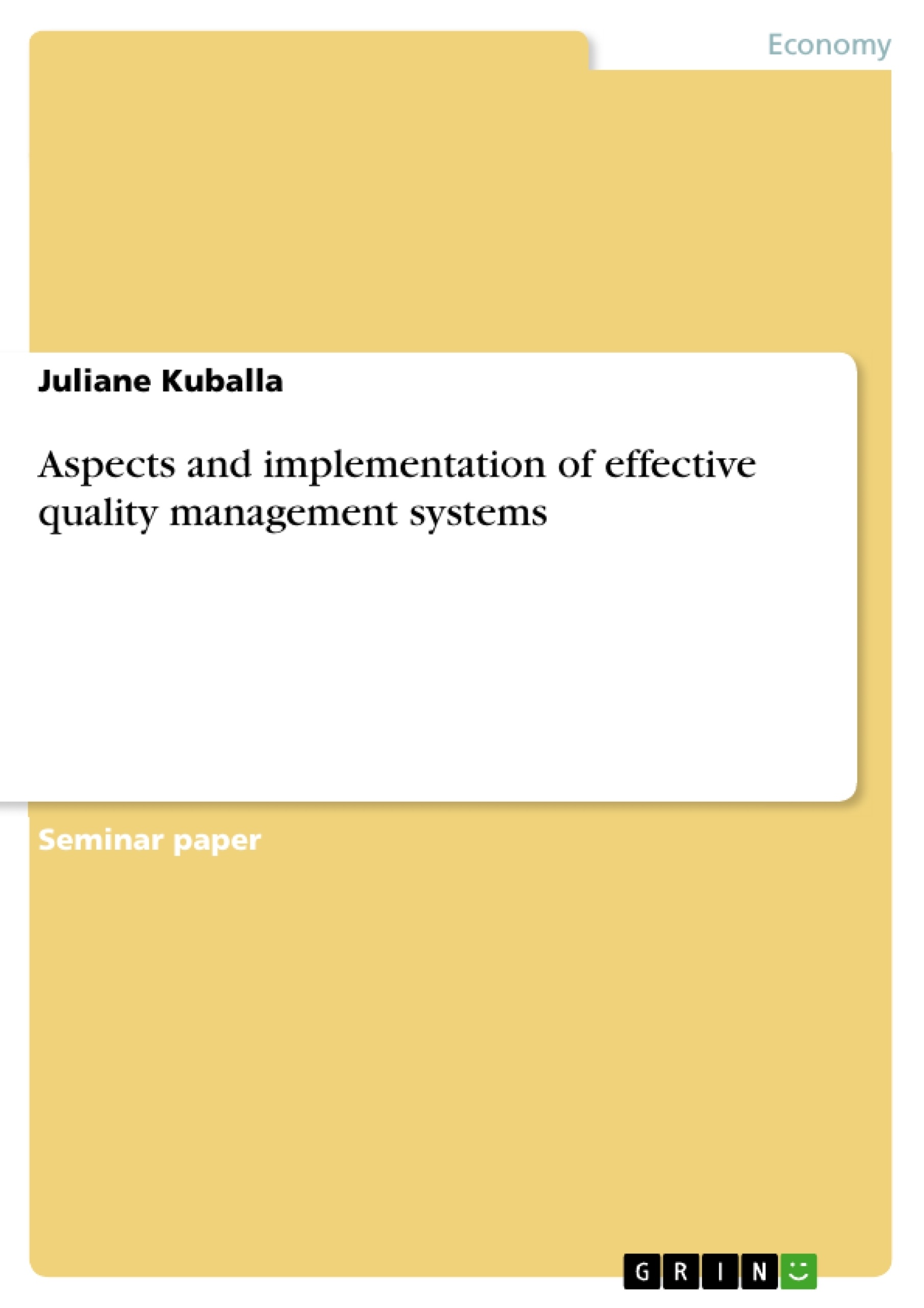Today due to the increasing global competition the relevance of quality has become as important as never before. Companies have realized that the satisfaction of customers’ needs must be placed in the centre of their efforts. In this context the development and manufacturing of high quality products and services at lower costs as well as the establishment of quality control systems are mainly responsible for gaining and sustaining competitive advantage. This article aims to demonstrate how quality systems must be implemented and developed to guarantee a satisfactory output. A short summary of historical events is provided to state the origin of quality systems. Further keynotes of pioneering quality gurus are presented to provide an understanding for the basic ideas behind quality management. Moreover key factors of TQM are defined and discussed to demonstrate in which way quality systems must be implemented to affect the creation of real quality outputs. In this context it is primarily highlighted why the principles of TQM are widely incompatible with traditional top-down management approaches. Moreover the need for local adaptation of TQM practices of global companies due to cultural differences is pointed out. In this context the different approaches to quality management in Eastern and Western countries are stated.
Table of contents
Abstract
Historical framework
Leading quality-gurus and their philosophies
Total Quality Management (TQM)
Critical success factors of TQM implementation
Customer orientation
Leadership commitment
Participation and teamwork
Process focus and continuous improvement
Management by fact
Quality management in a global context – managing cultural differences
Conclusion
References
Aspects and implementation of effective quality management systems
Abstract
Today due to the increasing global competition the relevance of quality has become as important as never before. Companies have realized that the satisfaction of customers’ needs must be placed in the centre of their efforts. In this context the development and manufacturing of high quality products and services at lower costs as well as the establishment of quality control systems are mainly responsible for gaining and sustaining competitive advantage. This article aims to demonstrate how quality systems must be implemented and developed to guarantee a satisfactory output. A short summary of historical events is provided to state the origin of quality systems. Further keynotes of pioneering quality gurus are presented to provide an understanding for the basic ideas behind quality management. Moreover key factors of TQM are defined and discussed to demonstrate in which way quality systems must be implemented to affect the creation of real quality outputs. In this context it is primarily highlighted why the principles of TQM are widely incompatible with traditional top-down management approaches. Moreover the need for local adaptation of TQM practices of global companies due to cultural differences is pointed out. In this context the different approaches to quality management in Eastern and Western countries are stated.
Historical framework
Even if people have always been aware of the important role of quality it has not been paid high attention to this fact for a long time. Quality control, if at all, was only focused on the final inspection of the end product (Vasconcellos, 2003, p. 45). The mainspring for change was initiated by the so-called quality revolution since the late 1970s. Thousands of Western countries became aware of the importance of quality due to the competition from Japan (Macdonald, 1998). Japanese companies had developed and adapted successfully different quality systems, and turned into the highest quality suppliers in the world while their American competitors continued to execute their traditional top-down management by objectives. Leading quality gurus challenged this approach and pointed up the need to change conventional procedures in order to achieve customer-driven quality objectives (Milakovich, 1995, p.13). During the 1970s and 1980s various quality system standards were developed around the world. A multinational team of quality professionals standardized the contents of these standards into the ISO 9000 quality system (Jaques, 1996).
Leading quality-gurus and their philosophies
The early development of the total quality movement in Japan was mainly influenced by only a few quality pioneers: Deming (14 Points), Juran (Quality Trilogy), Crosby (Five Absolutes of Quality Management, Fourteen Basic Elements of Improvement, Zero Defects), Feigenbaum (Three Steps to Quality), and Ishikawa (Company Wide Quality Control). They all taught quality management solutions that differ from each other only in little aspects (Krüger, 2001). Overall they state that the commitment of management is essential; that the execution of quality philosophies will save money; that the responsibility should be taken by management, not by employees; that it is crucial to improve continuously; that customers and their needs are essential, and they all identified the importance of changing the organizational culture. Each philosophy can be very successful but only if it is adapted correctly to the particular organization (Evans, Lindsay, 2005, p.110).
[...]
- Citar trabajo
- Juliane Kuballa (Autor), 2006, Aspects and implementation of effective quality management systems, Múnich, GRIN Verlag, https://www.grin.com/document/66936
-

-

-

-
¡Carge sus propios textos! Gane dinero y un iPhone X. -

-
¡Carge sus propios textos! Gane dinero y un iPhone X. -

-
¡Carge sus propios textos! Gane dinero y un iPhone X. -

-
¡Carge sus propios textos! Gane dinero y un iPhone X. -

-
¡Carge sus propios textos! Gane dinero y un iPhone X. -

-
¡Carge sus propios textos! Gane dinero y un iPhone X.

